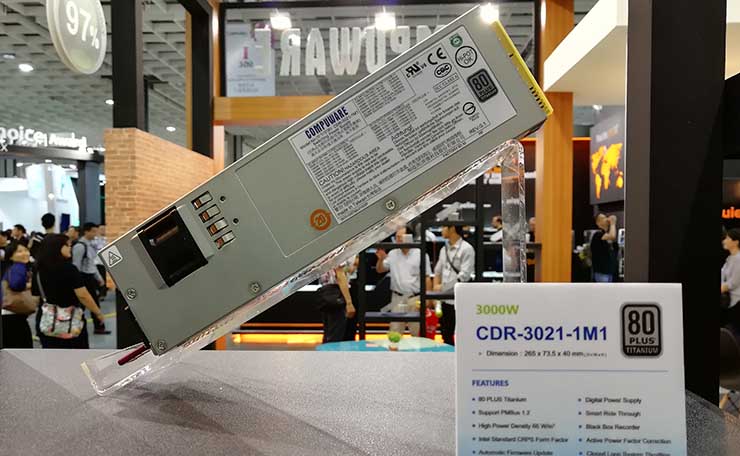A Compuware 3 kW power supply using Gallium Nitride semiconductors from GaN Systems, (Image: GaN Systems)
Traditionally built with silicon transistors, server power supplies have been commodity items for decades. Gallium nitride (GaN), a material initially used in high-performance radio frequency (RF) applications such as military radars and satellites, is steadily displacing silicon in power devices of all shapes and sizes, from consumer phone chargers to data center infrastructure including server, power distribution, and UPS.
“Nobody really wants power,” said Larry Spaziani, Vice President of Sales & Marketing for GaN Systems. “You need it, of course, but you don’t want to pay for it, you don’t want it to use up energy, you don’t want it to use up space.”
The overall GaN power device market is expected to grow with a nearly 91 percent year over year revenue growth in 2021, according to a March 2021 press release by semiconductor market research firm TrendForce and will more than double revenues again in 2022.
Exact numbers for GaN’s expansion into the data center are difficult to come by, since analysts are more focused on faster-moving markets using the material, including the automotive industry for electric vehicle fast chargers, 5G base stations, and adoption in consumer devices.
A Smaller, Cooler Power Option
Contents
On a watt-for-watt basis GaN-based power supplies take up a third of the physical size of their size of their silicon counterparts while generating less heat because of GaN’s physical property advantages, according to GaN Systems.
“The power density goes from 30 to 40 watts per cubic inch up towards 100 watts per cubic inch,” Spaziani said.
Replacing silicon power supplies with GaN delivers two immediate benefits, providing more computing power per rack footprint, which translates into extra profit, asserts Spaziani, “If you’re selling your compute power out as cloud service, you’re getting more compute for the same volume” – while reducing CO2 emissions.
Modeling power savings results from rolling GaN power supplies into the data center isn’t simple, but it could be significant when applied throughout.
“As an example: one of our recent reference designs improves the efficiency of the PFC stage of (a) server PSU from 98% to 99%,” said Steve Tom, Product Line Manager, GaN at Texas Instruments. “For a 4kW AC-DC, this is (around) 40W of savings, and in a 100MW datacenter this adds up quickly. Also, because less power less heat is generated, the power consumption for the cooling systems can also be reduced.”
Initial GaN adoption was slow due to cost and because it was unproven relative to silicon’s decades of dominance.
“It’s had a difficult adolescence,” said Stephen Oliver, Vice President of Corporate Marketing for Navitas. “It wasn’t until 2017, 2018 that you start to get the first GaN switch, whereas for 15 years prior to that it was hey, this thing is just around the corner, or a few blind corners.”
GaN’s first mass market power supply applications appeared in consumer electronics with high-end aftermarket cell phone and laptop chargers, and more recently inclusion in name brand products such as Dell, Lenovo, and LG. Over the last year, pricing for GaN parts has gone down over 50%, making system costs similar or lower than power systems built with silicon.
At the same time, industries such as automotive and aerospace have embraced it as a reliable technology, putting GaN into cars and satellite applications.
An Alternative Path for High Density Gear
Switching to GaN power supplies at the server and rack level provides an alternative path for higher compute densities than a complex solution using liquid cooling, given smaller size and better GaN efficiencies generating less heat at the power supply, GaN vendors say.
“We’ve had some customers with that exact problem,” Spaziani stated. “It’s a massive investment. If I can reduce the heat enough so I can use my traditional airflow, my cooling fans, I control the temperatures and don’t reinvent the entire infrastructure.”
GaN is not limited to server and rack level power supply plug-and-play replacements, but in higher-level DC distribution networks as well. Navitas GaNFast power ICs are being incorporated into 400V DC-DC converters, reducing energy loss and heat while packaged in a drastically smaller form factor than silicon-based converters, with similar solutions available for 650V networks.
GaN solutions also are available for 48V distribution networks for 48V-48V power distribution, as well as 48V-12V and 48V to 1V single stage converter applications.
Applying GaN circuitry into power applications also provides integrated and higher functionality for power protection, EMI tunability, and telemetry from the power supply for system intelligence, including fault reporting and junction temperature reporting, said Tom. “All of these features are relevant to UPS as well, where higher level of intelligence, protection, and system reliability are important.”
Migrating from silicon-based power to GaN in the data center is likely to be easier and faster at the server and rack level since it can be conducted on a plug-and-play basis a rack at a time during service windows, as well as in new builds on a rack and row level. Transition of DC distribution systems to GaN is a more major undertaking, but the devices are available and in use today.
GaN-using UPSes may take the most time to see widespread use given concerns about new technology in a critical application, but could offer the most benefits due to the level of intelligence GaN circuits bring into the device.



